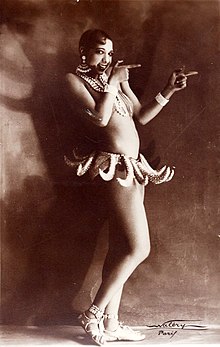Josephine Baker
| Josephine Baker | |
|---|---|
 Josephine Baker in her famous banana costume. | |
| Background information | |
| Orúkọ àbísọ | Freda Josephine McDonald |
| Ọjọ́ìbí | Oṣù Kẹfà 3, 1906 St. Louis, Missouri, U.S.[1][2] |
| Aláìsí | April 12, 1975 (ọmọ ọdún 68) Paris, France |
| Irú orin | Cabaret, Music hall, French pop, French jazz |
| Occupation(s) | Dancer, singer, actress, Civil Rights Activist, spy |
| Instruments | Vocals |
| Years active | 1921–1975 |
| Labels | Columbia, Mercury, RCA Victor |
Josephine Baker (June 3, 1906 – April 12, 1975) je onijo, akorin ati osere omo Amerika ara Fransi to je mimo kaakiri bi "Black Pearl," "Bronze Venus" ati "Creole Goddess". Oruko abiso re ni Freda Josephine McDonald ni St. Louis, Missouri, Josephine di ara Fransi ni 1937. O gbo ede Geesi ati ede Fransi daada.
Baker ni omobinrin Afrika Amerika akoko to di osere pataki ninu filmu kan, Zouzou (1934) tabi to gbajumo kari aye gegebi onifaaji. Baker ko lati sere fun agbo eleyameya ni Amerika, be sini o tun kopa ninu Iwode awon Eto Araalu. Coretta Scott King fun ni ipo olori iwode yi ni odun 1968, leyin ifikupa Martin Luther King, Jr.. Baker, however, turned down the offer. She was also known for assisting the French Resistance during World War II,[3] and received the French military honor, the Croix de guerre and was made a Chevalier of the Légion d'honneur by General Charles de Gaulle.[4]
Ìgbésíayé
[àtúnṣe | àtúnṣe àmìọ̀rọ̀]Wọ́n bí Josephine Baker pẹ̀lú orúkọ àbísọ Freda Josephine McDonald ní St. Louis, Missouri, ní orílẹ̀-èdè Amẹ́ríkà.[1][2] Ìyá rẹ̀ ni Carrie McDonald. Bàbá rẹ̀ ni Eddie Carson tó jẹ́ onílù. Carrie àti Eddie dá ẹgbẹ́ orin àti ijó sílẹ̀, had a song-and-dance act, playing wherever they could get work, and when Josephine was about a year old they began to carry her onstage occasionally during their finale. Josephine was always poorly dressed and hungry, and her playground became the yards of Union Station. From this she developed her street smarts.[5] When Baker was eight she began working as a live-in domestic for white families in St. Louis.[6] She was sent to work for a woman who abused her, burning Baker's hands when she put too much soap in the laundry.[7]

|
Àyọkà yìí tàbí apá rẹ̀ únfẹ́ àtúnṣe sí. Ẹ le fẹ̀ jù báyìí lọ tàbí kí ẹ ṣàtúnṣe rẹ̀ lọ́nà tí yíò mu kúnrẹ́rẹ́. Ẹ ran Wikipedia lọ́wọ́ láti fẹ̀ẹ́ jù báyìí lọ. |
Itokasi
[àtúnṣe | àtúnṣe àmìọ̀rọ̀]- ↑ 1.0 1.1 "Josephine Baker (Freda McDonald) Native of St. Louis, Missouri". Retrieved 2009-03-06.
- ↑ 2.0 2.1 "A – About Art Deco – Josephine Baker". Victoria and Albert Museum. Retrieved 2009-03-06.
- ↑ Àṣìṣe ìtọ́kasí: Invalid
<ref>tag; no text was provided for refs namedQR - ↑ Roberts, Kimberly (8 April 2011). "Remembering Josephine Baker". Philadelphia Tribune.
- ↑ Wood, Ian (2000). The Josephine Baker Story. United Kingdom: MPG Books. pp. 241–318. ISBN 1-86074-286-6.
- ↑ . Whitaker, Matthew C. (2011). Icons of Black America: Breaking Barriers and Crossing Boundaries. p. 64.
- ↑ "The Rise and Fall of Josephine Baker". Dollars & Sense 13. 1987.
